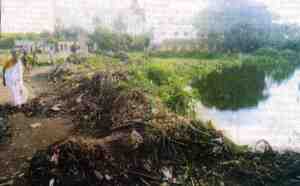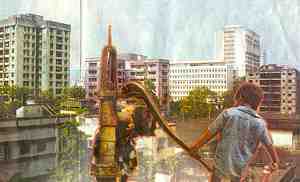|
| ||||||||||||
|
| ||||||||||||
|
|||||||||||||||||||||
| Home | Roots | Creative Forum | Future Vision | Stop'n Look! | Contact Us | Return to Top | |||||||||||||||||||||
| 01. Urbanization at the cost of a river: The Statesman, September 20, 1998, page unknown. |
| KAUSHIK GHOSH
STATESMAN NEWS SERVICE 
The Sonai River has turned into a continuum of ponds at Sodepur Ghola,
SODEPUR, (North 24-Parganas), Sept. 19. - Two decades ago, the Sonai was a river. Today, it's a series of 45 ponds, thanks to the Panihati Municipality. Flouting the Calcutta High Court orders, the municipality is allowing promoters to construct buildings on what was once the river, by filling wetlands with waste. The municipality was directed by the court to stop filling up the water bodies, to preempt constructions [by promoters]. The High Court had also said the "existing water bodies should not be disturbed in any way whatsoever." The High Court had also issued two similar orders to the adjoining Kamarhati Municipality on 12 December 1997 and 9 January 1998. Apparently, the court orders were not heeded. Local residents complained that filling the water-bodies had led to a total collapse of the drainage system. Since the area is inundated during the monsoon there is always the risk of an outbreak of malaria, Mr Shanti Roy, a resident of Sodepur's Ghola area said. A survey conducted by the CMDA in 1991
showed that there were 45 ponds in the area. According to the CMDA authorities,
there were 56 waterholes in the area when the first survey was conducted
in 1976. Of these, 11 were filled in the next 15 years.
At present, 75% of the stretch of the river's original course is covered by illegal constructions, said Mr Sujit Majumdar, secretary, Panihati Nagarik Committee. Ram Bhadrabati, Sodepur and Natagar, which have been illegally occupied, stands on what was once the original course of the Sonai, Mr Majumdar alleged. The river was originally under the jurisdiction of state irriagtion department. But in 1976, the CMDA was allowed to excavate the banks to instal the drainage system. But it is still a mystery how the municipality permitted promoters to build highrise buildings there. The state government prepared a drainage scheme to counter silatation but it was never implemented, Dr Sanmathanath Ghosh, the former vice-chairman of the municipality, said. Mr Dinesh Roy, a CPI-M councillor, said 40 per cent of the township in Panihati and Sodepur stood on land reclaimed in the past 30 years. "We have urged the municipality to check illegal construction and land filling in the area," he said. Mr Sunil Pal, a former chairman of Panihati municipality admitted buildings are being built without permission from authorities. But the municipality did not demolish any illegal structures on "humanitarian grounds", he said. The present chairman, Mr Monoronjan Sarkar, said: "The ecological balance in the area will not be disturbed." In this backdrop, the government claims to have taken some action. For example, the North 24 Parganas District Magistrate, Mr Arun Mishra, said a notice to stop filling in of wetlands in the area has been served to the municipality. [However] Mr Biswajit Mukherjee, law officer, WBPCB, said local residents have complained that wetlands in the Ghola area are being filled up. The WBPCB has also asked the Panihati municipality to take action soon. |
| Home | 'Stop'n Look!' Homepage | Synopsis List | Return to Top |
| 02. Over the Edge: Article in "Downtown" of The Statesman, Friday, November 6, 1998. |

Rapid urbanization and the consequent drain on groundwater reserves are playing havoc on Calcutta's subsoil level. If this exploitation continues unabated, nothing can stop the city from sinking, warns Amitava Mukherjee. Calcutta is now facing a new challenge. A supine administration and an unholy administrator-builder nexus have driven the city almost to the edge of the precipice. For some time now, environmentalists have been shouting themselves hoarse about the possibile submersion of the city surface as a result of unplanned and excessive use of its groundwater system. Statistical data confirms the worst: Calcutta is sinking! Sometimes back, Dr A B Biswas and Dr A K Saha, two well known geological scientists had said that the city had sunk by 30cm in the last 25 years. C R Dutta, another eminent engineer-turned-environmentalist, while corroborating this view, believes that the amount of submersion is as much as 60cm. All these experts agree on one point - if the reckless misuse of the city's groundwater resources is not stopped immediately, a serious catastrophe cannot be averted. It is really unfortunate that the state government and various other statutory bodies are yet to understand the value of a balanced groundwater system. One of the pricipal functions of groundwater is to mix with the soil and provide it with the ability to withstand pressure from the upper layers of the soil. When there is an uncontrolled withdrawal of groundwater, the water pressure id disturbed. The ability of the subsoil to sustain pressure from abve decereases, resulting in subsidence. That is exactly what is happening to Calcutta. Dutta has come up with some calculations on the reduced ground water pressure in Calcutta over the years. it gives us an idea of the extent to which subsoil water has been ruined. According to Dutta, water pressure in the city was reduced by 6 metres between 1956 and 1981. It is quite obvious that most of this occurred during recent times, due to the uncontrolled urbanization that has been permitted. Usually, water is available in Calcutta between 60m and 180m beneath the topsoil. By natural pressure, it comes up to a height of six or ten meters under the surface. However, there are some location specific variations. In 1956, smple surveys were carried out in Sinthee (in the north) and Gariahat (in the south). At Sinthee, water was available 4.27m below the surface whereas in Gariahat, it was traced at a depth of 5.64m. In 1981, another survey was carried out for a comparative study. According to it, water was available bewteen 9.3m and 12m in the north, while in the south, water was available between 11m and 13.38m. These studies lead to two conclusions:
The problem has been compounded by the fact that one of the two river water treatment plants - the Garden Reach water works - supplies only 40 million gallons of filtered water per day. A bulk of it comes from the Palta water works which churns out 180 million gallons of potable water. Together they make up 220 million gallons, which is insufficient to meet the city's needs. According to the Central groundwater Board, 62 million gallons of water are being lifted from underground everyday, although refilling - through various natural means like rains - amounts to only 45 million gallons. The CMC. however, claims that only 30 million gallons of water is lifted ever day. At the same time, it admits that nearly 30% of supplies are wasted due to pipe leakages. So how is the shortfall met. Simple - by pumping out more water from beneath the surface. An interesting fact is highlighted by the CMC. There are 12,000 small tubewells and and 315 heavy-duty tubewells in the city. Obviously, these figures do not include tubewells dug by residents within their own premises. In 1985, the corresponding figures were 6,000 and 230. So what is the solution? ... the only recourse seems to be to ensure that highrises do not instal deep tube-wells at will. Corporation officials admit that is the single reason for the rampant withdrawal of groundwater ... yet there has been an apathy on the corporation's part to enforce its CMC Act (1980) for preserving the city's subsoil water system. Sources in the CMC allege that there is virtually no vigilance system in the water supply department and licenses for deep tubewells are issued for the paymet of between Rs 500 and Rs 7,000 annually ... and the number of deep tubewells in the city has crossed the official mark of 4,000. In 1956, the water beneath the surface
flowed from the north to the south. By the first half of the 1970s, this
natural flow died out. The water level went down in a vast region starting
from central Calcutta to Ballygunge, Park Circus and Bhowanipore in the
south. A deep depression occured in the belt. In the 1980s, this depression
engulfed most parts of central
and south Calcutta. It now encompasses areas like Jodhpur Park in the south
and Maniktala and Beliaghata in the in the north. A new problem has also
surfaced. Water from different upper areas is now moving towards this depressed
belt. This is likely to affect the areas further south of this zone., with
the depression eating up any water that flows towards it, thus blocking
its further southward flow. At the same time, the thick layer of clay soil
just above the water bearing layer prevents rainwater seeping through and
makes natural refilling difficult ...
There was enough time for the state
government to ward off this presently calamitous situation. Scientists
believe that, if the rampant water exploitation is not halted immediately,
the city will sink by another three cm. in another two years.
That's not all. Since Calcutta has
a peculiar topographical character - a tilt not towards the Ganga, but
inwards - the immediate consequence of subsidence might be prolonged inundation
of certain parts during the monsoons - which has in fact been happening
with increasing frequency. A comprehensive plan needs to be urgently
implemented to ward off a future disaster.
|
| Home | 'Stop'n Look!' Homepage | Synopsis List | Return to Top |
| 03. Minister warns Medha, Bahuguna: The Statesman, November 8, 1998, front page. |
UNITED NEWS OF INDIA

Sunderlal Bahuguna & Medha Patkar FARIDABAD (Haryana), Nov. 7. - Environmentalists who try to stall power projects will face legal action, the Union power minister said today. "The days of Sunderlal Bahuguna and Medha Patkar are over," Mr P R Kumarmangalam said after laying a foundation stone for the National Hydro-electric Power Corporation office and launching the NHPC website here. The government will find out who funds the NGOs that back these "eco-terrorists", he thundered."Now, power projects are set a deadline and have to be completed within that." The minister cited the Tehri Dam controversy and asked why a hydel project should be disrupted when it did not endanger the environment. Hydel projects are the "cleanest as far as the environment is concerned". NHPC needs to get its act together fast, for hydro-electricity is crucial to meet the country's demand of peak power at peak time, the minister said. Mr Kumarmangalm promised to help the NHPC financially so that it could increase its production to 30,000 MW. It now produces 3,000 MW. "Funds are no problem. But the results will have to show". The minister said progress in the hydro-electricity sector is slow though a large part of the budget is earmarked for it. A meeting with the environment minister. Mr Suresh Prabhu, has been scheduled for 18 November to speed up the hydro-electricity projects awaiting environmental clearences, he said. The 50MW Parbati Stage I and the 500 MW Parbati Stage II projects in Himachal Pradesh will be converted to joint-venture undertakings. |
| Home | 'Stop'n Look!' Homepage | Synopsis List | Return to Top |
| 04. Chemicals in flood waters kill fish, birds; The Statesman, Sept. 12, 1998, page 3. |
| STATESMAN NEWS SERVICE
MALDA, Sept. 11. - Chemicals flowing into the flood waters has resulted in the death of fish and birds in Malda town during the last few days. Urea from a godown in Banshmare near Malda railway station has contaminated the stagnant waters further. Authorities here are afraid that if the dead fish are sold in the market, they would result in deaths of several people. Two other godowns storing chemicals were also flooded. Most of the stocks from one has been removed. But the rest have mixed with the flood waters, causing poisoning of the water. Sackfuls of dead birds and fish were dumped on BS Road, near the irrigation department office. "A probe is on to find out the extent of damage caused by the urea mixed with the water," a health department official said. |
| Home | 'Stop'n Look!' Homepage | Synopsis List | Return to Top |
| If you
find our presentations not up to your expectations, or if you do not see
the article/contribution(s) which may have been archived due to paucity
of disc space, please contact us/use the feedback form, or mailto:sankalpatrust@hotmail.com
We shall succeed only with your active participation in these processes. Please send in your comments about our presentations, and your own contributions for inclusion in this page. Meanwhile ... |
© 2000 Sankalpa Trust